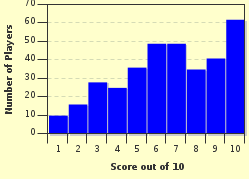Quiz Answer Key and Fun Facts
1. As suggested by its name, an infrared spectrometer uses infrared electromagnetic radiation in its machine. This infrared radiation will result in which molecular activity?
2. One of the unit of measurement used for the wavelength of molecular absorption is micrometers. Its symbol is the Greek letter lambda. A more common unit is measured in cm^-1, which is defined as the number of complete loops in 1 cm. Its symbol is nu bar. What is this unit called?
3. Bond stretching frequencies depend on two major factors, namely atomic weight and bond stiffness. The frequency absorbed is directly proportional to the bond strength (stiffness) but inversely proportional to the atomic weight. Which of the following bonds will give the highest absorption frequency value?
4. Depending on the location of the triple bond, the alkyne (C triple bond C) functional group gives different values of bond stretching frequency. Which type of alkyne will give higher frequency value? Terminal alkyne or internal alkyne?
5. A conjugated C double bond C (for example, 1,3-cyclohexadiene) will give lower absorption frequency value compared to that of an isolated C double bond C (for example, 1,4-cyclohexadiene).
6. A bond with more s character will absorb at higher absorption frequency since the s orbitals are closer to the nucleus of an atom compared to the p orbitals. Which of the following C-H bonds will give the highest absorption frequency?
7. Will the -O-H functional group of both alcohols and carboxylic acids show the same absorption frequency?
8. Which of the following compounds will show two spikes at the -N-H stretching?
9. A typical infrared (IR) spectrum is divided into 2 parts, namely the left part with the absorption peaks at 1400 -4000 cm^-1 and the right part with the absorption peaks at 600 - 1400cm^-1. Beginners in this field only study the left part. The right part is studied by expert spectroscopists. What is the name given to this right part?
10. A C double bond O bond absorbs at 1710 cm^-1. It may indicate an aldehyde, a ketone, or a carboxylic acid. You are told that an unknown chemical compound contains only three elements, namely C, H and O. You run an IR test and notice that the IR spectrum does not show any peak at the 1710 cm^-1 region. This IR spectrum suggests that the compound will most probably be a (an) ___.
Source: Author
Matthew_07
This quiz was reviewed by FunTrivia editor
crisw before going online.
Any errors found in FunTrivia content are routinely corrected through our feedback system.

